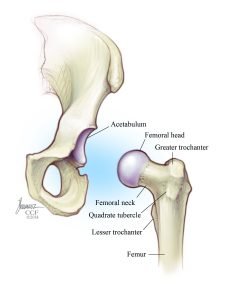Avascular Necrosis of the Hip
What is Avascular Necrosis?
Avascular necrosis (AVN), also called osteonecrosis, aseptic necrosis, or ischemic bone necrosis, is a condition that occurs when there is loss of blood to the bone. Because bone is living tissue that requires blood, an interruption to the blood supply causes bone to die. If not stopped, this process eventually causes the bone to collapse. AVN can happen in many bones such as the hip, knee, and foot.
SYMPTOMS OF AVASCULAR NECROSIS
In its early stages, AVN typically cause no symptoms; however, as the disease progresses it becomes painful. At first you may experience pain when you put pressure on the affected bone. Then, pain may become more constant. If the disease progresses and the bone and surrounding joint collapse, you may experience severe pain that interferes with your ability to use your joint. The time between the first symptoms and collapse of the bone may range from several months to more than a year.
How can Avascular Necrosis affect the Hip?
 The top two risk factors of Avascular Necrosis of the Hip is from too much corticosteroid use for too long paired with or even just too much alcohol consumption. Avascular Necrosis (AVN), or also called osteonecrosis, can affect the hip by reducing blood flow to the femoral head in the leg. Hip pain is the first sign and it can get worse. A dull, throbbing pain can be felt in the hip and radiate to the groin or buttock. As the femoral head begins to die the cartilage that covers it will begin to deteriorate. This deterioration will cause rough pieces of the femoral head to start to wear away at the cartilage in the acetabular socket. As this damage progresses the entire joint in the hip can be irreparably compromised over time by arthritic damage.
The top two risk factors of Avascular Necrosis of the Hip is from too much corticosteroid use for too long paired with or even just too much alcohol consumption. Avascular Necrosis (AVN), or also called osteonecrosis, can affect the hip by reducing blood flow to the femoral head in the leg. Hip pain is the first sign and it can get worse. A dull, throbbing pain can be felt in the hip and radiate to the groin or buttock. As the femoral head begins to die the cartilage that covers it will begin to deteriorate. This deterioration will cause rough pieces of the femoral head to start to wear away at the cartilage in the acetabular socket. As this damage progresses the entire joint in the hip can be irreparably compromised over time by arthritic damage.
What is the treatment for avascular necrosis of the hip?
The ideal treatment of avascular necrosis of the hip would be to stop the progression of the disease as early as possible. If the disease progress is halted early enough then conservative treatments may be all that is needed. If conservative treatments fail to halt the disease, or halt the disease but too late, then surgical intervention may required to restore blood flow or even replace the joint.
Conservative Treatment for Avascular Necrosis of the Hip
NSAIDs for pain and swelling can be used to make you more comfortable. Rest can help slow the damage and irritation to the joint, specific exercises to increase flexibility in the joint can be used under supervision. Electrical stimulation may be used to try and regrow healthy bone tissue.
Surgical Treatment of Avascular Necrosis of the Hip
There are many different interventions depending on the progression of the disease.
- Core decompression – some of the internal components of the bone will be removed to relieve pressure and allow for vascular tissues to replace the extra bone. This procedure can halt the progression of new bone death.
- Bone Grafting – healthy bone tissue may be removed from other parts of the body to replace damaged sections of tissue in the joint.
- Hip Resurfacing (Osteotomy) – pieces of bone can be reshaped by removing sections to restore a proper shape to the joint.
- Total joint replacement – in the situation of the joint being too far gone to repair to a level of acceptable functionality and pain, then total joint replacement may be considered as a final option.

